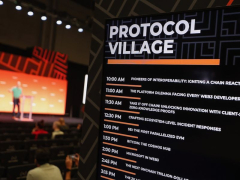June 25: The Solana Foundation announced the launch of Solana Actions and blockchain links (“Blinks”) to its suite of developer tools. According to the team: “These tools offer way to integrate blockchain transactions into any platform, creating a seamless and intuitive Web3 experience for users. Multiple Solana ecosystem projects will be using Solana Actions and Blinks at launch, including Cubik, Sanctum, Tensor, Realms, Access, Jupiter, Helium, Truffle, Phantom and Backpack.” (SOL)
Acre Introduces ‘Simple BTC Yield’
June 25: Acre introduced “simple BTC yield” on Mezo, a Bitcoin economic layer, thanks to our liquid staked Bitcoin, stBTC. According to the team: “Acre strips away the complexity of Bitcoin yield, giving a simple Bitcoin in, Bitcoin out process for depositors. In the background, Acre converts BTC to tBTC, and deploys it into various yield-generating strategies across crypto.”
ENSO, Intent Engine for Chain Abstraction, Raises $4.2M
June 25: ENSO, an intent engine for chain abstraction, has closed a $4.2 million funding round with Ideo Ventures, Hypersphere and more than 60 angel investors, according to the team: “The funds will support the launch of their L1 Cosmos-based blockchain this year and continued product development.”
ZKsync Developer’s New ‘Elastic Chain’ Could Compete With Polygon’s AggLayer
June 25: Matter Labs, the main development firm behind the layer-2 network ZKsync, has introduced a new roadmap called ZKsync 3.0, aimed at making the ecosystem more interconnected – including a new “Elastic Chain” that somewhat resembles rival Polygon’s AggLayer, released earlier this year. At the core of ZKsync “3.0” is the v24 upgrade, released June 7, turning “ZKsync from a single ZK chain into an Elastic Chain,” the Matter Labs team wrote in a blog post shared with CoinDesk.
Portal to Bitcoin Announces 18 New Hires After Raising $34M in March
June 25: Portal to Bitcoin, the bridgeless interoperability protocol on Bitcoin formerly known as Portal that raised $34 million in a seed round in March, has hired 18 people, according to the team. They include Dan Edlebeck, former head of ecosystem at Sei Labs, to be chief marketing officer.
Bitget, in Alliance With Foresight Ventures, Announces $20M TON Ecosystem Fund
June 25: Crypto exchange Bitget announced a $20 million TON Ecosystem Fund in alliance with Singapore-based investment firm Foresight Ventures, “aiming to support early-stage projects building on The Open Network (TON),” according to the team: “This strategic initiative highlights the duo’s commitment to fostering innovation and development within the TON ecosystem.”
Protocol Village is a regular feature of The Protocol, our weekly newsletter exploring the tech behind crypto, one block at a time. Sign up here to get it in your inbox every Wednesday. Project teams can submit updates here. For previous versions of Protocol Village, please go here. Also please check out our weekly The Protocol podcast.
Metis Starts Community Selection for Sequencer Node Operators
June 24: Metis, an Ethereum layer-2 network, planned to announce the opening of a community selection process for its first batch of external sequencer node operators, “becoming the first L2 to enable shared ownership and control of a critical piece of infrastructure,” according to the team: “By operating these nodes, entities become network owners. As owners, entities gain substantial influence and governance rights over the network’s strategic direction, and a share in the revenue involving sequencing rewards and fees. Distributed ownership creates robust decentralization, bringing stronger reliability to Metis and enhancing liveness and economic security.” The voting process will be live from Monday through June 28.
Gitcoin Releases Free Tool for Grant Making Industry
June 24: Gitcoin, a project for providing funding for Ethereum development, released what it says is a free tool, “Grants Program Canvas,” to “launch and grow a high-impact grants program,” with downloadable templates, worksheets and step-by-step walk-thrus, according to the team: “Packed with years of expertise and industry insights, Grants Program Design is a detailed playbook designed to support growth leads with a structured, visual approach to grants program design.”
Artela, for Extending Blockchain Functionality, Details New Parallel Architecture
June 23: Artela, a blockchain designed to extend the functionality of other blockchains, released its latest whitepaper, “Artela Scalability: Parallel Execution Stack and Elastic Blockspace.” According to a blog post, the whitepaper “introduces a brand new parallelized blockchain architecture: not only achieving parallel execution but also supporting parallel storage. On top of all this parallelization, we will further realize nodes that support elastic computing, achieving elastic node block space and bringing predictable performance to dApps.”
:format(jpg)/cloudfront-us-east-1.images.arcpublishing.com/coindesk/VVPTGMP6LBE6TAOQWXBVXLYB7A.png)
Cosmos DAO Osmosis to Adopt Fee-Free Bitcoin Bridge
June 21: Decentralized autonomous organization (DAO) Osmosis voted to adopt a fee-free Bitcoin bridge to allow bitcoin (BTC) to move into the Cosmos ecosystem. Key to the process is a revenue-sharing agreement with Bitcoin bridge Nomic, according to an emailed announcement shared with CoinDesk on Friday. A bridge is a way of improving interoperability of blockchains by allowing users to move crypto assets from one system to another.
:format(jpg)/cloudfront-us-east-1.images.arcpublishing.com/coindesk/K262CLTU55FJXOYLL6CY6LQ4TQ.jpeg)
Aleph Zero’s EVM-Compatible ‘zkOS’ Generates ZK Proofs in < 1 Second
June 21: Aleph Zero, a privacy-enhanced public blockchain operating on a Substrate stack developed by Polkadot developer Parity Technologies, introduced zkOS, an EVM-compatible privacy layer that generates zero-knowledge proofs in under a second on consumer devices, according to the team: “This allows for private transactions and dApp interactions without revealing underlying data. ZkOS uses Halo2 with KZG commitments for faster proof generation and provides a zkToolkit to simplify integration for developers. Based on benchmarks, zkOS can execute proofs in 600-800ms on MacBooks. ZkOS is designed to be faster, more user-friendly and easier for developers to integrate into Ethereum applications. ZkOS is now live on testnet.”
Arbitrum to Launch ‘Orbit Layer Leap’ for One-Click Transfers to Layer-3 Chains
June 21: Arbitrum, the leading Ethereum L2 scaling solution by total value locked, was set to launch Orbit Layer Leap on Friday, “enabling users to bridge funds from Ethereum L1 to L3 chains within the Arbitrum Orbit ecosystem in a single-click,” according to the team: “This groundbreaking feature eliminates the need to interact with L2, enhancing user experience and interoperability. Layer Leap will initially support ProofOfPlay and RariChain, reflecting Arbitrum’s commitment to driving mainstream adoption of layer-2 and layer-3 solutions.”
Farworld, Building Gaming on Farcaster, Raises $1.75M
June 20: Farworld Labs, the Farcaster-native gaming company, has closed its $1.75 million pre-seed funding round, co-led by Lemniscap and Variant. According to the team: “The funding will enable Farworld Labs to expedite the rollout of upcoming Q3 releases, including the highly anticipated launch of the Farcade platform in conjunction with top-tier studios and developers. Built on decentralized social media protocols, the Farcade is a platform and suite of tools for developers to build crypto-native games that integrate with onchain social, making games instantly playable within social media feeds with just a single click.”
Celo Foundation Appoints Nakagawa as Executive Director; Varshney Transitions to Head of Ecosystem
June 20: The Celo Foundation is elevating homegrown and Web3 native talent into key senior leadership positions. According to the team: “Eric Nakagawa has been appointed to the new role of Executive Director of the Celo Foundation. He will work closely with Rene Reinsberg to oversee the Foundation’s daily operations. Isha Varshney has transitioned from head of DeFi to head of Ecosystem. She will oversee projects building on Celo, and lead business development efforts with both Web2 and Web3 firms. Sophia Dew joins the Celo Foundation as developer relations lead to support builders developing on the emerging Ethereum L2.”
:format(jpg)/cloudfront-us-east-1.images.arcpublishing.com/coindesk/RN4773LPENA27NXJ47JIRULVEM.jpeg)
Botanix Labs Hires Stoner as Head of Security
June 20: Botanix Labs, building an EVM-equivalent layer-2 network atop Bitcoin, announced the appointment of security expert and industry veteran Ron Stoner as its new Head of Security, according to the team: “With this addition, the Botanix Labs team is uniquely positioned to develop industry-leading infrastructure that securely scales Bitcoin-native financial tools. Ron Stoner brings a wealth of experience in designing and testing blockchain-based networks as one of the most respected hackers, educators, and security professionals in the cryptocurrency industry.”
POKT, Decentralized RPC Project, Expands Into AI Inference
June 20: POKT Network, a project for decentralized RPC infrastructure processing, is expanding into AI inference services, according to the team: “The network’s open-source, permissionless design aligns incentives among model researchers, hardware operators, API providers and users. Utilizing its Relay Mining algorithm, POKT creates a transparent marketplace for cryptographically verified usage, enabling AI researchers to disseminate work and generate revenue without maintaining infrastructure. This aims to decentralize AI, competing with centralized entities and supporting broad participation.”




